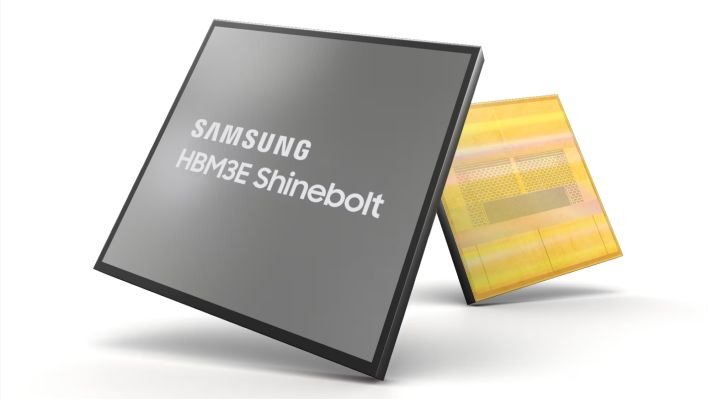Samsung talks up its fast and power-efficient GDDR7 memory
Coming to a GPU near you not-so-soon.

Samsung has divulged some updates on its next generation memory products—including GDDR7 memory—at its annual Memory Tech Day in San Jose. Alongside GDDR7, Samsung announced its Shinebolt HBM3E memory, which is being developed for upcoming AI and compute GPUs.
GDDR7 memory has been in development for some time. It's set to appear in next generation Blackwell RTX 50-series and RDNA 4 RX 8000-series graphics cards. Samsung didn't disclose too many details, but one of the most interesting little nuggets was the reveal of a target of 50% less stand-by power. That'll help to reduce overall idle power consumption, and hopefully lower it for multi-monitor setups and video playback too.
GDDR7 memory is set to operate at 1.2V compared to the 1.35v operating voltage of GDDR6 and GDDR6X. Assuming we see high speeds of up to 32Gbps as predicted, a total bandwidth of 1TB/s is possible over a 256-bit bus. In the case of a 384-bit bus, that bandwidth would increase by a further 50%.
Samsung previously disclosed that its GDDR7 memory will utilize PAM3 (pulse-amplitude modulation) signaling as opposed to GDDR6X's PAM4. While PAM4 is better suited to higher frequencies, PAM3 is easier to implement, making it a better option for affordable consumer graphics cards. That partly explains why we've never seen affordable GDDR6X cards, even though faster memory would be beneficial when considering the relatively thin memory buses of current generation mid-range GPUs.
PAM3 delivers lower average bit-error rates, but given the higher inherent performance offered by GDDR7, PAM4 is seen as the preferable option for now. Of course, that leaves the door open to a future GDDR7X standard. Is that something Micron might have up its sleeve? We'll have to wait and see. A hypothetical RTX 5090 Ti with a 512-bit bus and GDDR7X would result in a bandwidth rating of above 2TB/s. That sounds tasty indeed, though the price of such a card would be excessive, to put it mildly.
Given where we are on the current release cycle, GDDR7 equipped cards are surely a year away at best. I'd expect it to be restricted to high end cards. Next gen entry level cards are very likely to stick with GDDR6, at least until manufacturing really ramps up and it becomes cost effective enough to consider.


Best CPU for gaming: The top chips from Intel and AMD.
Best gaming motherboard: The right boards.
Best graphics card: Your perfect pixel-pusher awaits.
Best SSD for gaming: Get into the game ahead of the rest.
Samsung also talked about its next generation HBM3E memory. While we'd love HBM3E memory to be included in gaming graphics cards, its expense and complexity rules it out. Samsung says its Shinebolt memory can hit up to 9.8Gb/s per pin which would give a single HBM3E stack 1.225GB/s of bandwidth. That's much higher than the 819Gb/s offered by HBM3.
Keep up to date with the most important stories and the best deals, as picked by the PC Gamer team.
If you add multiple stacks, those numbers skyrocket. According to numbers sourced from our sister site Anandtech, a flagship GPU could theoretically contain 216GB of memory with an astonishing 7.35TB/s of bandwidth. A reference RTX 4090 delivers a hardly sluggish 1,008GB/s in comparison.
Samsung has not said if it is mass producing GDDR7 yet, which isn't surprising given there's at least a year to go before GDDR7 cards are launched. But it is good to see that it's talking freely about it at this stage, which points towards a mature standard that's readily able to hit the market in volume when next generation cards do arrive.

Chris' gaming experiences go back to the mid-nineties when he conned his parents into buying an 'educational PC' that was conveniently overpowered to play Doom and Tie Fighter. He developed a love of extreme overclocking that destroyed his savings despite the cheaper hardware on offer via his job at a PC store. To afford more LN2 he began moonlighting as a reviewer for VR-Zone before jumping the fence to work for MSI Australia. Since then, he's gone back to journalism, enthusiastically reviewing the latest and greatest components for PC & Tech Authority, PC Powerplay and currently Australian Personal Computer magazine and PC Gamer. Chris still puts far too many hours into Borderlands 3, always striving to become a more efficient killer.

